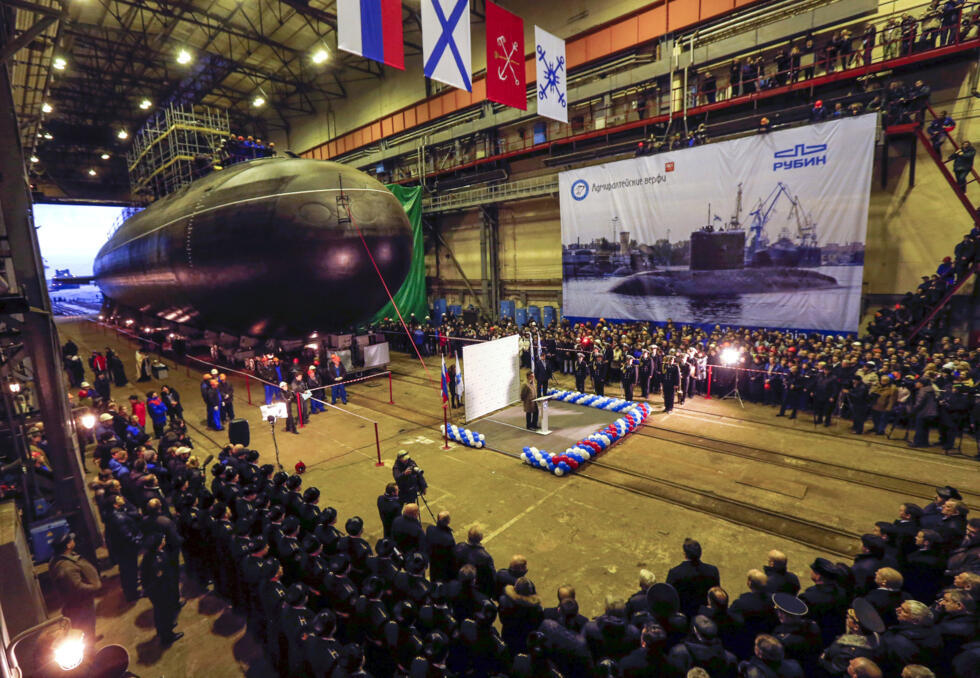The news that a short-range Russian stealth hunter was circling in the Strait of Gibraltar first came to public attention on September 27. The anti-Kremlin Telegram channel VChK-OGPU reported that the 74-metre-long Kilo-class Novorossiysk “currently on combat duty in the Mediterranean” had experienced a technical failure, and that fuel was leaking into the bilge, the very bottom of the vessel hull.
“The submarine has neither the spare parts nor the qualified specialists onboard to fix the malfunction,” VChK-OGPU wrote, and warned that the sub “now poses an explosion hazard”.
An alleged September 26 sighting of a submarine surfacing in the Strait of Gibraltar appeared to confirm its location. According to online sleuths, a US Navy maritime patrol plane also flew over the area where the submarine was spotted for several days in a row.
Neither Russian authorities nor state-controlled media have confirmed the sub’s presence in the Mediterranean.
FRANCE 24 takes a closer look at why the Novorossiysk was in one of the busiest and most strategic naval corridors in the world.
What kind of submarine is it?
The Novorossiysk is 74 metres long and can carry a crew of around 50 people. Alexandre Vautravers, a defence expert and editor-in-chief of the Swiss Military Review, said the diesel-electric sub is relatively modern.
“It was developed in the 1980s. It doesn’t belong to the submarines from the 1940s and 1950s which were frequently subject to breakdowns.”
The Kilo-class – a name given to these types of Soviet-era submarines by NATO – “isn’t very sophisticated”, he said.
“It was designed to be produced in large numbers rather than to give the Russian fleet a cutting edge. Russia has also exported a lot of these submarines because they don’t contain any secret technology.”

The Novorossiysk belongs to one of the more recent Kilo-class models, and was put into service in August 2014. It joined Russia’s Black Sea fleet in September 2024.
Like other submarines in its category, the Novorossiysk’s main purpose is to “operate in coastal waters where the seas are not too deep”, Vautravers explained.
It is equipped with torpedoes, however, which would make a potential fire onboard particularly dangerous, and is capable of carrying Kalibr cruise missiles – the Russian equivalent of US Tomahawk missiles. It can also deploy naval mines.
Prior to its sighting near Gibraltar, the Novorossiysk was spotted off the French coast of Brittany in 2022, prompting authorities there to dispatch a vessel to follow it. In July this year, it was spotted again – this time in the English Channel – and was subsequently tailed by the British navy.
What was the Novorossiysk doing in the Strait of Gibraltar?
Although VChK-OGPU claims the Novorossiysk was on a “combat mission”, it does not necessarily mean it was intending to target British positions on Gibraltar, or anything else for that matter.
“Most often, these types of missions are about intelligence gathering or the discreet transport of personnel and equipment," Vautravers said.
The Strait of Gibraltar is perfect for these types of covert operations. It is the only maritime gateway between the Atlantic and the Mediterranean, and all vessels passing through it are closely monitored.
Read moreFrance probing Russian-linked oil tanker for ‘serious offences’, Macron says
On top of that, Russia has a tradition of maintaining a naval presence in the Mediterranean, explained Basil Germond, an international security expert and maritime affairs at Lancaster University.
“It’s long-term naval deployments to achieve political, economic and strategic objectives by projecting its military influence in a region,” he said.
He described Russia’s ability to exert influence in the Mediterranean as “very limited” at the moment, however, pointing to the war in Ukraine and its recent loss of the naval base in Tartus, Syria.
“It was a major setback for the Russian navy,” he said.
This means that the Novorossiysk is likely one of the few Russian warships still operating in the Mediterranean, showcasing Moscow’s waning influential power in the region.
How serious is the damage to Novorossiysk?
With no official confirmation from the Kremlin, the extent of the reported damage – or whether there is any at all – remains unclear.
But in line with VChK-OGPU’s claim that Novorossiysk lacked both spare parts and competent staff to repair the potentially explosive fuel leak, Germond noted that: “Russian warships are known to be poorly maintained, with crews that are untrained to handle these types of situations."
Russia’s war efforts in Ukraine have resulted in even less spare parts and specialised staff being available.
Vautravers underscored that the Novorossiysk “is not a nuclear sub. So the environmental and safety impact of an explosion [of the ship itself] would be limited.” The risks, he said, are rather tied to the type of arms that might be onboard. Mines and missiles would make the situation much more dangerous.
Another challenge the crew faces, Germond said, is that Russia has no ports nearby and the Novorossiysk would have to be towed all the way to Saint Petersburg to be repaired. “Considering the current climate, Russia definitely won’t ask a NATO country for help if it isn’t able to resolve the problem by itself,” he said.
One of the few remaining solutions, a source told the VChK-OGPU channel, would be for the crew members to “start pumping out the bilge” themselves, into the sea.
This article was adapted from the original in French by Louise Nordstrom.











 English (US) ·
English (US) ·